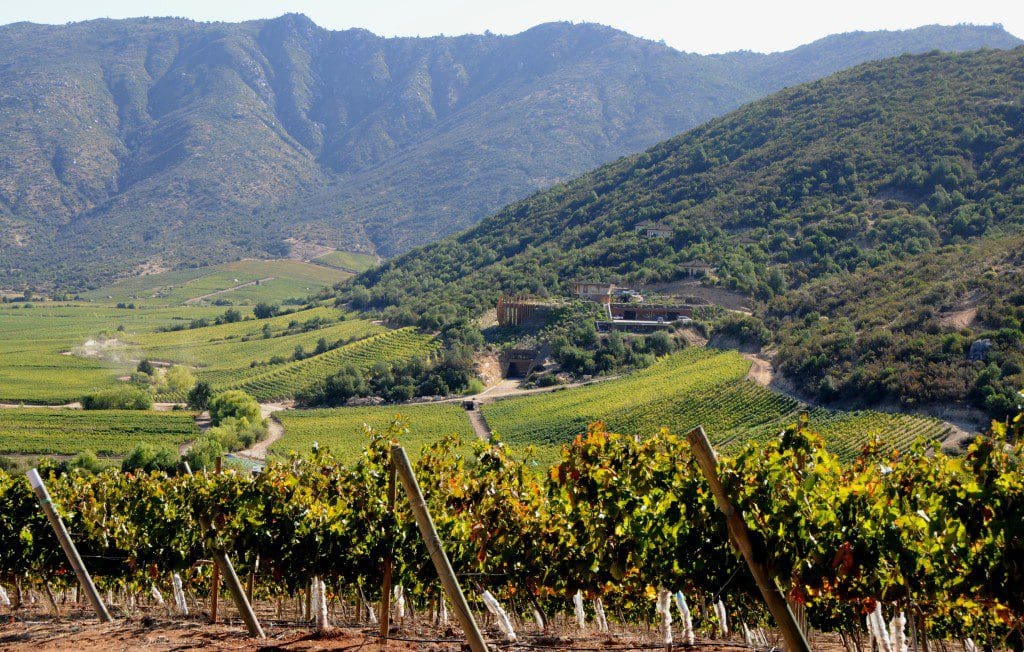 The many vineyards of Chile have a very important job. They grow the wine grapes and produce the renowned Chilean Cabernet Sauvignons, Merlots, Carmeneres and Chardonnays that are enjoyed worldwide. The harvest season from February to May is a time of celebration and the best time for wine travel in Chile. Towns hold festive celebrations that include rodeos, grape stomping contests, traditional foods and of course plenty of wine tastings. Wine travel in Chile is also fun and tasty during the growing season with winery tours, wine tasting courses or lunch in the vineyards.
The many vineyards of Chile have a very important job. They grow the wine grapes and produce the renowned Chilean Cabernet Sauvignons, Merlots, Carmeneres and Chardonnays that are enjoyed worldwide. The harvest season from February to May is a time of celebration and the best time for wine travel in Chile. Towns hold festive celebrations that include rodeos, grape stomping contests, traditional foods and of course plenty of wine tastings. Wine travel in Chile is also fun and tasty during the growing season with winery tours, wine tasting courses or lunch in the vineyards.
The fertile Central Valley is the heart of Chile’s wine country. It runs about 250 miles from Santiago southward and is part of, but not to be confused with the geological Central Valley, which runs over 620 miles north/south between the spine of the Andes to the west and the coastal ranges of the east. The wine region is so varied the appellation is subdivided into four wine growing regions: Maipo Valley, Rapel Valley, Curico Valley and Maule Valley. Travel Maestro tip: Most quality Chilean wines specify their sub-region, so a wine that references only “Central Valley” on the label is usually a mass-produced wine made from several sources.
Santiago, the capital and major city of Chile, sits in the middle of the Maipo Valley. This region is renowned for world-class Cabernet Sauvignon and three of Chile’s oldest wineries are in Maipo Valley. Santiago itself has three wineries in the city, two with vineyards, and several more just outside. With excellent gastronomical options, a lively nightlife and proximity to wonderful hiking, biking, skiing and beach activities, wine is not the only reason to visit Santiago.
The Rapel Valley, which is further divided into the Colchagua and Cachapoal Valleys, is south of Santiago. The warm, dry climate is suited to red varietals for which the Colchagua area is a rising star. The pretty little town of Santa Cruz is the perfect base for visiting the Colchagua wineries to the east and west of the town. It has a charming central plaza, a notable museum, and most importantly, the Wine Route office that offers full and half day tours of nine local wineries with transportation and lunch included. Travel Maestro tip: One of the best wine festivals in Chile takes place in Santa Cruz during the harvest in March.
Further south, the Curico Valley grows more grape varieties (over 30) and has more viticultural tradition than anywhere else in Chile. The area’s primary industry has been wine since the mid-1800s, but in the 1970s Spanish winemaker Miguel Torres brought in new technology and foreign investment and with them international recognition. The area has a wine route, lovely nature reserves and seaside resorts that visitors will enjoy.
The Maule Valley is the largest wine region in Chile and with its center being about 180 miles south of Santiago it’s also one of the most southern wine producing areas. The city of Talca is the most important cultural and industrial city of the region and nearby Huiquilemu Cultural Village is of interest. The Maule Valley Wine Route has 16 vineyards with Cabernet Sauvignon being the predominant grape, although the Carmenere is stealing a lot of attention recently.
For help in planning your wine travel in Chile, contact Covington Travel’s expert vacation advisors.






Leave a Reply